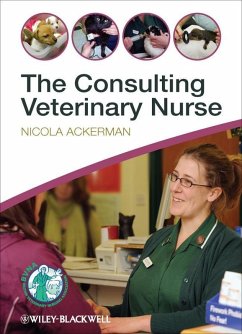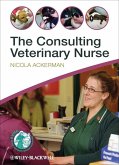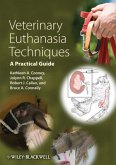The Consulting Veterinary Nurse is an invaluable source of information for all veterinary nurses setting up and conducting their own nursing clinics in small animal practice. From the basics of setting up the consulting room to running and marketing individual clinics, this book provides a comprehensive coverage of the role of the consulting veterinary nurse. A large section of the book details specific clinics run by nurses, including nutritional assessments, behavioural clinics, puppy parties, seasonal information campaigns, senior pet clinics and medical clinics for a full range of conditions from arthritis and dental problems to epilepsy and cancer. A chapter specifically on rabbit clinics is also included.
Written by an experienced senior veterinary nurse, this is a vital guide for all veterinary nurses seeking to develop their consulting role and contribute effectively to the long-term success of their practice.
KEY FEATURES
Written by an experienced senior veterinary nurse, this is a vital guide for all veterinary nurses seeking to develop their consulting role and contribute effectively to the long-term success of their practice.
KEY FEATURES
- Provides a comprehensive guide to the role of the consulting veterinary nurse
- Details specific nutritional, medical and behavioural clinics run by nurses
- Includes advice on presentation, marketing and communicating with clients
- Discusses client compliance and internal procedure and protocol
- Contains sample diet history sheets and unit conversion charts for use in practice
- Endorsed by the British Veterinary Nursing Association
Dieser Download kann aus rechtlichen Gründen nur mit Rechnungsadresse in D ausgeliefert werden.
"This book will enable VNs to become more involved inclinics and will ensure their skills are utilised. Certainlya book for every VN to have in the library." (BSAVA, 1 March 2014)
"To summarise, The Consulting Veterinary Nurse will be auseful book for many nurses, especially those who have a keeninterest in clinical nutrition, and those looking to promotenutrition within the practice . . . It may also offer somesuggestions for medical clinics that may not have otherwise beenconsidered." (The Veterinary Record, 1 October2013)
"From handling senior pet clinics to client compliance andeducation, this covers clinics organized for a range of animalconditions and is written by an experienced senior vet nurse. Anyveterinary collection will find this filled
with specifics." (Bookwatch, 1 January2013)
"The Consulting Veterinary Nurse' is a highlyinformative, well-written book and deserves its place in thepractice library or, better still, the nurses' consultationroom." (Veterinary Record, 2 February 2013)
The Consulting Veterinary Nurse is a useful reference forall veterinary nurses who run clinics in their practice. TheAuthor, Nicola Ackerman, is an experienced Registered VeterinaryNurse and she has drawn on her knowledge to provide a comprehensiveguide, which includes information on how to run efficient andeffective well pet clinics and medical clinics. The book contains awealth of information on all aspects of running a clinic,including: how to provide clients and patients with an excellentlevel care; the answers to questions which clients frequently askin a clinic; how to gather a patient's history; carrying outan examination and the necessary equipment for this - along with alist of common abbreviations. Nicola also discusses the roleof the veterinary nurse and the consideration of nutritional andbehavioral issues within the setting of a veterinary nurse-leadclinic. This book will be a useful reference for veterinary nurseswho are experienced in running clinics and those who are juststarting out, alike. - Helen Farrant on behalf of the BVNA
"To summarise, The Consulting Veterinary Nurse will be auseful book for many nurses, especially those who have a keeninterest in clinical nutrition, and those looking to promotenutrition within the practice . . . It may also offer somesuggestions for medical clinics that may not have otherwise beenconsidered." (The Veterinary Record, 1 October2013)
"From handling senior pet clinics to client compliance andeducation, this covers clinics organized for a range of animalconditions and is written by an experienced senior vet nurse. Anyveterinary collection will find this filled
with specifics." (Bookwatch, 1 January2013)
"The Consulting Veterinary Nurse' is a highlyinformative, well-written book and deserves its place in thepractice library or, better still, the nurses' consultationroom." (Veterinary Record, 2 February 2013)
The Consulting Veterinary Nurse is a useful reference forall veterinary nurses who run clinics in their practice. TheAuthor, Nicola Ackerman, is an experienced Registered VeterinaryNurse and she has drawn on her knowledge to provide a comprehensiveguide, which includes information on how to run efficient andeffective well pet clinics and medical clinics. The book contains awealth of information on all aspects of running a clinic,including: how to provide clients and patients with an excellentlevel care; the answers to questions which clients frequently askin a clinic; how to gather a patient's history; carrying outan examination and the necessary equipment for this - along with alist of common abbreviations. Nicola also discusses the roleof the veterinary nurse and the consideration of nutritional andbehavioral issues within the setting of a veterinary nurse-leadclinic. This book will be a useful reference for veterinary nurseswho are experienced in running clinics and those who are juststarting out, alike. - Helen Farrant on behalf of the BVNA









